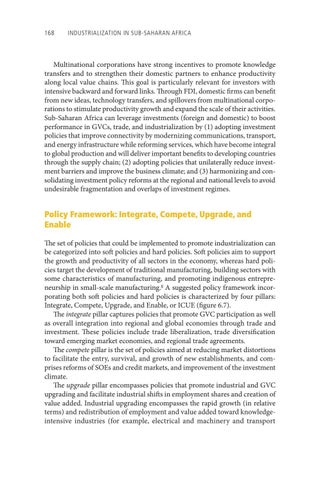168 Industrialization in Sub-Saharan Africa
Multinational corporations have strong incentives to promote knowledge transfers and to strengthen their domestic partners to enhance productivity along local value chains. This goal is particularly relevant for investors with intensive backward and forward links. Through FDI, domestic firms can benefit from new ideas, technology transfers, and spillovers from multinational corporations to stimulate productivity growth and expand the scale of their activities. Sub-Saharan Africa can leverage investments (foreign and domestic) to boost performance in GVCs, trade, and industrialization by (1) adopting investment policies that improve connectivity by modernizing communications, transport, and energy infrastructure while reforming services, which have become integral to global production and will deliver important benefits to developing countries through the supply chain; (2) adopting policies that unilaterally reduce investment barriers and improve the business climate; and (3) harmonizing and consolidating investment policy reforms at the regional and national levels to avoid undesirable fragmentation and overlaps of investment regimes.
Policy Framework: Integrate, Compete, Upgrade, and Enable The set of policies that could be implemented to promote industrialization can be categorized into soft policies and hard policies. Soft policies aim to support the growth and productivity of all sectors in the economy, whereas hard policies target the development of traditional manufacturing, building s ectors with some characteristics of manufacturing, and promoting indigenous entrepreneurship in small-scale manufacturing.6 A suggested policy framework incorporating both soft policies and hard policies is characterized by four p illars: Integrate, Compete, Upgrade, and Enable, or ICUE (figure 6.7). The integrate pillar captures policies that promote GVC participation as well as overall integration into regional and global economies through trade and investment. These policies include trade liberalization, trade diversification toward emerging market economies, and regional trade agreements. The compete pillar is the set of policies aimed at reducing market distortions to facilitate the entry, survival, and growth of new establishments, and comprises reforms of SOEs and credit markets, and improvement of the investment climate. The upgrade pillar encompasses policies that promote industrial and GVC upgrading and facilitate industrial shifts in employment shares and creation of value added. Industrial upgrading encompasses the rapid growth (in relative terms) and redistribution of employment and value added toward knowledgeintensive industries (for example, electrical and machinery and transport

